
PUMPA - SMART LEARNING
எங்கள் ஆசிரியர்களுடன் 1-ஆன்-1 ஆலோசனை நேரத்தைப் பெறுங்கள். டாப்பர் ஆவதற்கு நாங்கள் பயிற்சி அளிப்போம்
Book Free DemoThe word "vascular" means a system of tubes that transport materials across the plant body. In IX standard Plant tissues, the following topics were explained;
- Complex permanent tissue
- Vascular tissue
- Types of Vascular tissue
- Structure of xylem and phloem
- Functions of xylem and phloem
- Components of xylem and phloem
In this topic, the types of arrangement of vascular tissues are explained.
Xylem and phloem are the tissues present in a vascular tissue system of a plant. This tissue system helps the plant transport food, water and minerals from the root to the different parts of the plant.
- Xylem transports water and minerals
- Phloem transports food materials
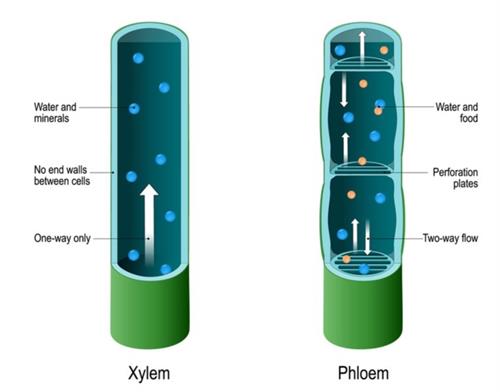
Biological structure scheme of inner vascular in plant
These two tissues present in bundles, i.e., they are packed together closely and are called vascular bundles.
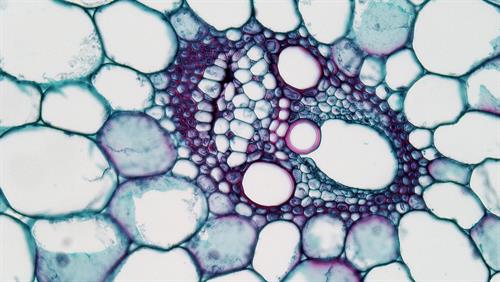
Monocot Stem: Vascular bundle in maize
Vascular bundles are of three types;
- Radial bundle
- Conjoint bundle
- Concentric bundle
1. Radial bundles:
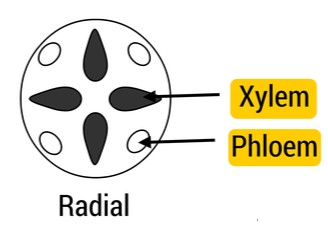
Radial bundle
In the radial bundle, the xylem and phloem are present in the form of patches at different radii in alternative positions to each other.
The above diagram is showing the transverse section of a root. The arrangement of the xylem and phloem in the form of the radial bundle is shown. If we observe the arrangement of the xylem and phloem circumferentially, tissues are arranged in an alternative manner. Also, they are present at different radii. Generally, radial vascular bundles are present in roots.
2.Conjoint bundles:
In this type of bundles, the xylem and phloem are bundled together and lie on the same radius.
There are two types of conjoint bundles.
a) Collateral:
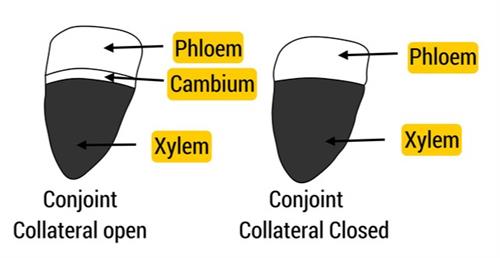
Left to right: Conjoint collateral open and conjoint collateral closed bundle
The xylem is in the centre (inner side), while the phloem is on the periphery (outside).
In the dicot stem, cambium is present between phloem and xylem. Because of cambium, such vascular (collateral) bundles can form secondary xylem and phloem tissues and are called open vascular bundles.
In monocot stem, the collateral bundles do not have cambium. Hence they lost the ability to form secondary tissues and are referred to as closed vascular bundles.
The above picture is showing the conjoint collateral bundles. The presence of cambium is referred to as an open bundle. In contrast, the absence of cambium is referred to as a closed bundle.
b) Bicollateral:
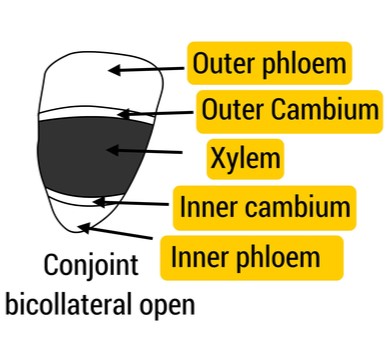
Conjoint bicollateral open
In a sandwich, the bread slice takes up two sides, while the fillings are on the inside. Similarly, in this type of bundle, the phloem is present on both the outer and inner side of the xylem.
Example:
Cucurbita
c) Concentric bundles:
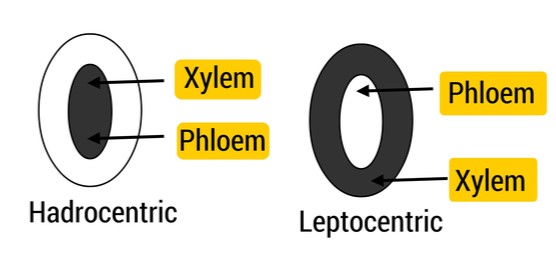
Left to right: Amphicribral or Hadrocentric and Amphivasal or Leptocentric
A vascular bundle in which the xylem completely surrounds the phloem or vice versa is called a concentric vascular bundle.
It is of two types.
1. Amphivasal or Leptocentric: When the xylem surrounds the phloem tissue from all sides, the vascular bundle is called the 'amphivasal vascular bundle'.
Example:
Dracaena
2.Amphicribral or Hadrocentric: In this type of vascular bundle, the xylem is located at the centre, surrounded by a ring of phloem.
Example:
Ferns
The above picture is showing the amphivasal and amphicribral vascular bundle. We can see that xylem and phloem are arranged in concentric circles.
Note:
Protoxylem - The first formed primary xylem cells in a plant shoot/root.
Metaxylem - Later formed primary xylem cells in a plant shoot/root.
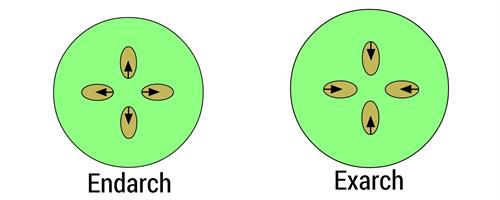
Left to right: Endarch and exarch
The above picture is showing the endarch and exarch arrangements of the protoxylem and metaxylem.
Endarch | Exarch |
| Protoxylem lies towards the centre, and the metaxylem lies towards the periphery. | Protoxylem is directed towards the periphery. The metaxylem lies in the centre. |
| This type of arrangement is found in the stem. | This type of arrangement is found in roots. |
Reference:
https://upload.wikimedia.org/wikipedia/commons/a/ae/Xylem_Development.svg